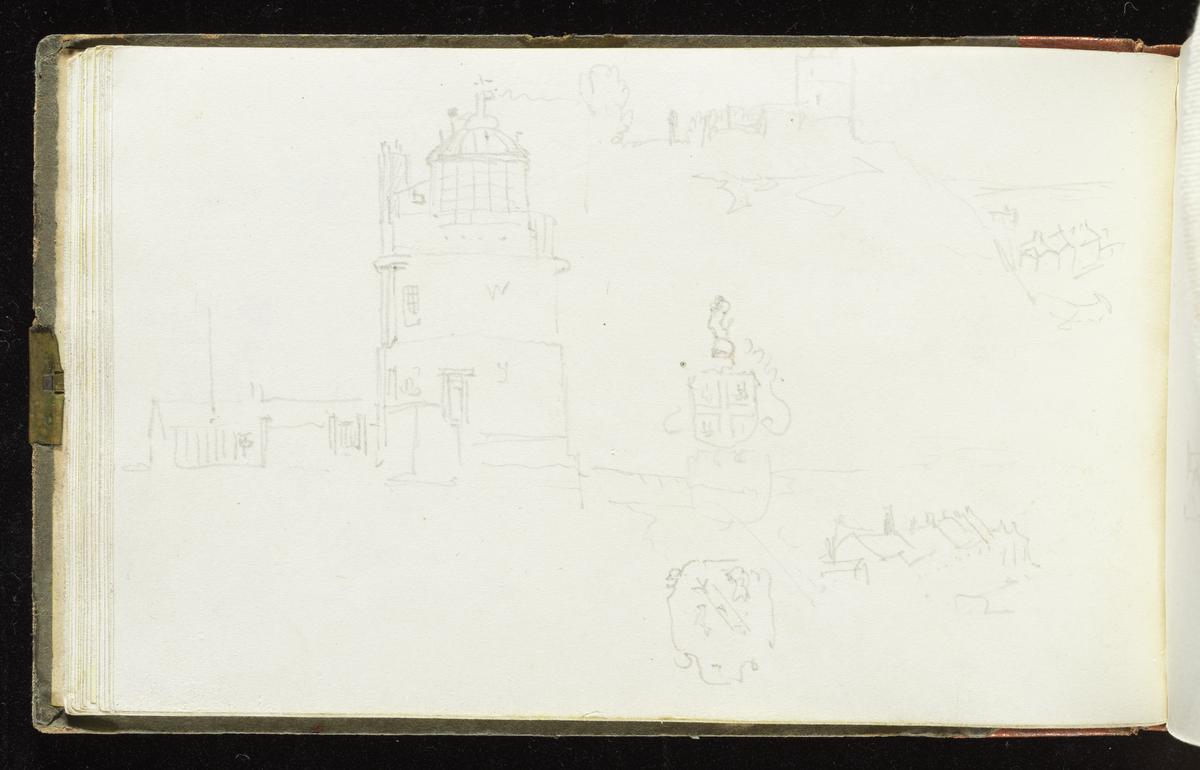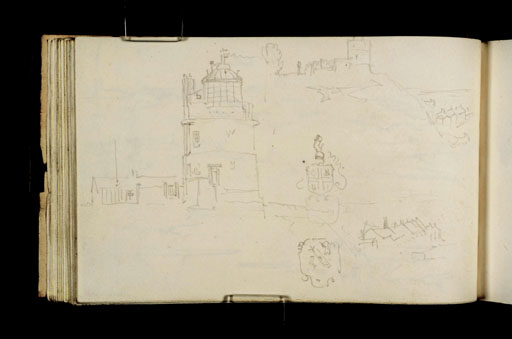Joseph Mallord William Turner Lowestoft Lighthouse c.1824
Image 1 of 2
Joseph Mallord William Turner,
Lowestoft Lighthouse
c.1824
Joseph Mallord William Turner 1775–1851
Folio 35 Verso:
Lowestoft Lighthouse c.1824
D18225
Turner Bequest CCIX 35a
Turner Bequest CCIX 35a
Pencil on white wove paper, 115 x 118 mm
Watermarked ‘al[lee] | 18[19]’
Inscribed in pencil by Turner ‘W’ | ‘Y’ centre towards top left
Watermarked ‘al[lee] | 18[19]’
Inscribed in pencil by Turner ‘W’ | ‘Y’ centre towards top left
Accepted by the nation as part of the Turner Bequest 1856
References
1909
A.J. Finberg, A Complete Inventory of the Drawings of the Turner Bequest, London 1909, vol.II, p.632, CCIX 35a, as ‘A lighthouse. Probably at Lowestoft’.
1975
Andrew Wilton, Turner in the British Museum: Drawings and Watercolours, exhibition catalogue, Department of Prints and Drawings, British Museum, London 1975, p.131 under no.208.
1981
Eric Shanes, Turner’s Rivers, Harbours and Coasts, London 1981, p.40 under no.87.
1997
Martin F. Krause, Turner in Indianapolis: The Pantzer Collection of Drawings and Watercolors by J.M.W. Turner and his Contemporaries at the Indianapolis Museum of Art, Indianapolis 1997, p.162 under no.48.
Here Turner studies Lowestoft lighthouse on Suffolk’s North Sea coast. The first lighthouse at Lowestoft was erected in 1609 and rebuilt in 1628 and 1676; Turner pictures it here in its third incarnation, positioned atop cliffs overlooking the Denes.1 The tower is topped with a glass lantern room from which Argand lamps and silvered parabolic reflectors projected beams of light to aid mariners navigating their vessels at sea (see Tate impression T05100).2 A small outbuilding can be seen at the foot of the tower; this is probably the keeper’s quarters, a fuel store or boathouse. Another view of the lighthouse overlooking the Denes is pictured at top right.
Turner has also jotted two coats of arms to the right of the lighthouse. The uppermost is the coat of arms for Trinity House: a private corporation governed under Royal Charter whose principal responsibility is to ensure the safe passage of shipping and the welfare of seafarers. The corporation was established in 1514 during the reign of Henry VIII, but it was his daughter, Elizabeth I, who granted Trinity House its first coat of arms in 1573.3 The design on the escutcheon is a red cross with four ships, their fore and topsails raised. Above the shield is a closed helm (helmet) and a crest with a demi-lion rampant holding a sword in his dexter paw. The coat of arms below belongs to Britain’s celebrated diarist Samuel Pepys. Pepys, in addition to his position as Tory MP, was Chief Secretary to the Admiralty under King Charles II and James II and also Master of Trinity House. Turner has rendered Pepys’ arms cursorily here: visible is a diagonal band running across the shield decorated with three fleur-de-lis and two lions rampant. The rest of Pepys’ coat of arms has not been sketched.
These sketches and those on Tate D18226–D18227; Turner Bequest CCIX 36–36a are connected to a watercolour and gouache drawing entitled Lowestoffe Lighthouse of around 1827 (Indianapolis Museum of Art). It is one of a series of eight vignette designs picturing sites along the east coast of England (see general introduction for more information). An engraving of this drawing exists, produced by J.C. Allen, though it was never published (see Tate impression T06613).
Alice Rylance-Watson
January 2015
‘Lowestoft’, Trinity House, accessed 14 January 2015, http://www.trinityhouse.co.uk/lighthouses/lighthouse_list/lowestoft.html
‘History’, Trinity House, accessed 14 January 2015, http://www.trinityhouse.co.uk/th/about/history.html and ‘Coat of Arms’, Trinity House History, accessed 14 January 2015, https://trinityhousehistory.wordpress.com/tag/coat-of-arms/
How to cite
Alice Rylance-Watson, ‘Lowestoft Lighthouse c.1824 by Joseph Mallord William Turner’, catalogue entry, January 2015, in David Blayney Brown (ed.), J.M.W. Turner: Sketchbooks, Drawings and Watercolours, Tate Research Publication, August 2016, https://www


